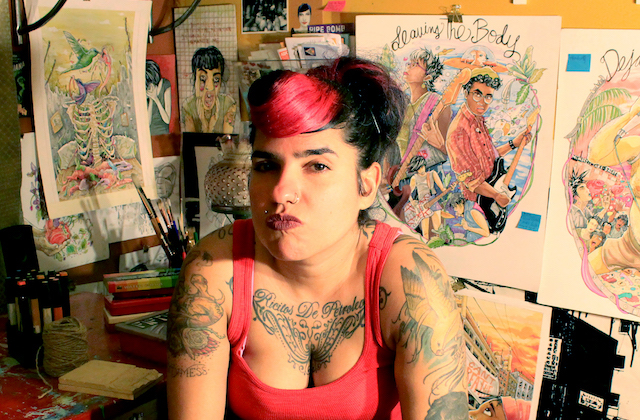You could argue that tarot, an ancient divination tool using a set of cards, is having a bit of a moment. A number of publications published tarot predictions for the year ahead. And activist adrienne maree brown pulls a tarot card each day and posts it on Instagram, along with a reflection and the hashtag #movementtarot.
Queer Latina artist Cristy C. Road agrees that tarot cards, which are used in many ways—as tools for predicting the future, gaining insight about a challenging question or providing themes for reflection and inspiration—are more popular recently. "I do think that it’s become trendy and hip," she told Colorlines via phone. "[But] it’s been trendy and hip before. [Tarot] has had so many moments of commercialization, even starting in the 1500s."
Road isn’t just a casual tarot fan. The illustrator, musician and graphic memoirist spent the last seven years creating Next World Tarot, an original, fully-illustrated deck featuring portraits of real people, most of whom posed for her. Sixteen-hundred decks are currently on their way around the world to her 300+ kickstarter supporters and the hundreds of pre-orders she received throughout the process. While producing the deck, Road also earned her master’s degree in fine art illustration at Fashion Institute of Technology in New York City, where she focused her thesis on the history of tarot.
{{image:2}}
While the project began after an invitation to collaborate on a deck by queer author Michelle Tea, Road has been fascinated with tarot since high school. "When I first got the Internet, I was addicted to this website where you could get tarot readings," she says. It wasn’t until 2009, when Road’s mother gifted her a tarot deck for Christmas, that she started doing her own readings. "My mom and family were really into the tarot exploration—even like, ‘Oh, can you give me a reading?’"
Road says it’s given her a new form of connection with her Cuban-American family, one she struggled to find growing up as a queer teenager in Miami. "The more I got into magic and my spiritual power, there was just more to talk about with my family," explains Road. "There was stuff they’d grown up around [in Cuba] with santeria. As tarot became a bigger part of me, I could [more easily] exist in these places where I grew up."
While Road doesn’t know of any tarot roots in Cuba, she did spend a long time researching the medium for her master’s thesis project. "The history is super ambigous," says Road. Most of the documented history traces tarot back to 15th century Italy and a set of cards referrenced by Italian royalty in letters. But Road believes that there are likely Chinese and Egyptian roots. In her research she found Chinese playing cards and money cards that date back to pre-1000 AD, and Egyptian and Syrian fortune-telling cards from the 13th century.
Tarot has seen various moments of renewed popularity, including in the ’70s, when Road says people in the U.S. worked to "make tarot more radical, more accessible and more feminist." You could say her deck follows similar principles. While Michelle Tea left the project (and is releasing her own tarot guidebook later this year), the separation allowed Road to fully focus on her vision of the deck. Of the 78 cards, 68 are portraits of people of color, and all of the adults portrayed in the deck identify as queer, says Road. While she has left the cards anonymous, some of the people portrayed are more well-known, and might be recognizable. For example, trans activist Jennicet Gutiérrez is the inspiration for the "revolution" card.
Road’s deck follows the traditional tarot format, but she’s written original descriptions for each card and renamed a few, including the Revolution card, which typically is called the Tower. People who already have experience with tarot can use her cards in standard ways, but for those new to the medium, she’s offered instructions on how to work with the deck.
Since the beginning of the project, the theme of the deck has been apocalyptic, but Road says that topic took on special meaning as she finished this past year. "It felt like this is when this needs to happen," says Road. She was particularly inspired by the Dakota Access Pipeline protests, which led to her Revolution card. "It’s an image of the war for oil, and it references the DAPL and war in the Middle East," she explains.
Road decided to self-publish her deck after challenges working with her usual publishing companies. "I dealt with this the way I used to publish my ‘zines in the ’90s," she explains about her past projects like Green’Zine. In 2015, she launched a successful Kickstarter for the deck, which raised almost $30,000, the majority of which she used to fund printing.
For the first time, Road has been able to live from the earnings of her art. She has currently paused on selling copies through her online store, and is focused on working with retail stores to stock the deck. Road plans to reopen online sales for the remainder of her first printing later this month.
At the end of the day, Road is grateful for what tarot, and connecting to her own magic, has offered her. "A lot of people do feel lost with certain healing methods that used to work but don’t anymore," Road says of the renewed interest in tarot. She sees many of her activist punk friends, who used to think anything spiritual felt too religious, now getting into tarot or astrology. "Allowing magic and intuitive responses to be a guide more than anxiety is my dream."
